The kettlebell is special to me. The kettlebell has linked me to several important events in my life. And it was part of the beginning of my friendship with Pavel. (Pavel Tsatsouline—the man who introduced kettlebells from behind the Iron Curtain to the rest of the world.)
My Friendship and Work With Pavel
My meeting of Pavel is a funny story unto itself. I had heard about kettlebells and about this “Mad Russian” about ten years ago. At an NSCA meeting, I saw a couple of kettlebell and strength demonstrations and then I was on for my keynote talk about back strength. Coming down from the podium after my talk there was a gathering of delegates wanting to have a discussion. Pavel was among them.
The group sought thoughts on strength techniques and then Pavel asked a delegate (Dr. Chris Holder, SFG Team Leader) to lay on the floor, instructing him to wrap his arms around the knees. Pavel then picked the man off the floor.
The gaggle of delegates thought he was nuts to attempt such a dangerous lift. I said, “That was a perfect lift—you applied several principles to achieve high performance while sparing your joints.” That was the start of a terrific friendship.
Over the years, Pavel has taught me kettlebell techniques and some principles from the Russian strength culture, many of which are novel in North America. Some of these have led to experiments where we were able to better understand the mechanisms and benefits to the techniques. For example, we published an investigation of kettlebell mechanics that documented joint loading and the neuromuscular challenge in the Journal of Strength and Conditioning Research.
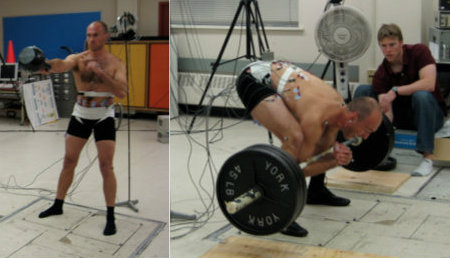
How Kettlebells Can Help Those With Back Injuries
As a back injury specialist, I design exercise progressions to begin with corrective and therapeutic exercise. Then the remaining four-stage sequence follows: stability/mobility, endurance, strength, and power. Kettlebells can figure into every stage for the appropriate patient/client and situation.
Nearly all people who develop painful back conditions have movement flaws. Perhaps the most common is to move the spine when it is under load. Repeated compression of the spine while it is bending almost guarantees eventual disc bulges. The spine can withstand high loads if it is postured close to its neutral curvature.
The corrected movement pattern requires hip hinging to bend and lift. It would be typical to start with the short-stop squat movement pattern and evolve the progressions to a kettlebell swing. This is furthered with the stability/mobility stage where the emphasis becomes core stiffening to create a fixed point. This allows the hips the express their athleticism. Dan John’s goblet squat using a kettlebell is a wonderful tool to enhance hip mobility and squat form.
The endurance progression begins with our “big three” exercises to ensure 3D core stability, which will eventually progress to various kettlebell exercises with the appropriate intervals and intensity.
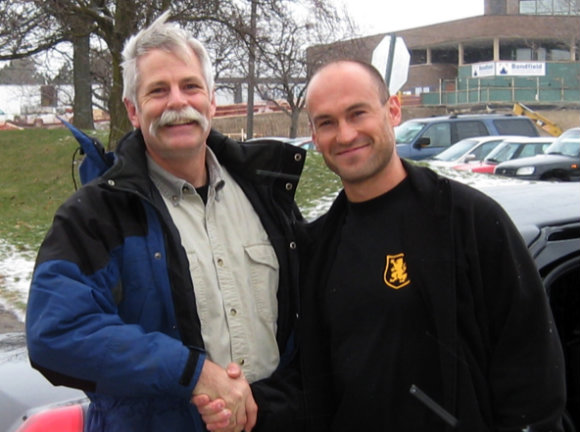
Strength exercises are designed according to the goals of the client, but almost always have a kettlebell component. Consider carrying exercises. We discovered the weakest link in the strength profile of many athletes is lateral core strength. This is required to hold the pelvis up or indeed lock the pelvis to the core, which is needed to run and cut quickly and skilfully or exert strength while moving on their legs. (In other words, this is needed by nearly every athlete who stands on their legs and moves.)
Upon foot plant, the spine and pelvis wants to collapse to the floor on the swing leg side. Lateral core strength creates stiffness so muscular explosive contraction around the hip propels the body without energy losses that rob performance. We train this strength beginning with the suitcase carry. Then the progression uses a kettlebell racked on the backside of the forearm with the fist at the chin. Then a bottoms-up kettlebell carry requires more focus on a stiffened core so that the lift position and bottom-up is not lost.
Power generation can be functionally enhanced with pulsing techniques during the swing and snatch. Bruce Lee used these precise techniques over thirty years ago and once again Pavel showed them to me.
Kettlebell work is not for everyone during recovery from injury. However, when used appropriately it is a unique and irreplaceable training tool. All of these techniques are demonstrated in the DVD The Ultimate Back: Enhancing Performance available from BackFitPro.
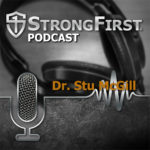
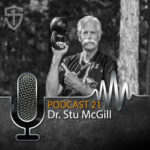

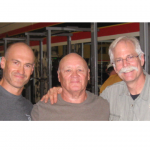

Very awesome article. Lots of respect for Dr. McGill and the Chief.
I found out about kettlebells accidentally. I was researching the military press on Youtube!
So Pavel did a human get up at the conference?
Awesome!
I actually was in attendance at that fateful NSCA Annual meeting in 2004. It was my first and (so far) only NSCA Annual meeting that I attended mainly to hear Prof. McGill’s presentation. I had heard him previously at an ACSM Health and Fitness Summit and was very familiar with research findings and writings at the time. I stood alongside him and Pavel in the exhibit area watching and listening them animatedly exchange ideas, knowing that I was witnessing history in the making!
I, too, remember that day when the good doctor met Pavel, out in the rather-cramped corridor, by some exhibit case. (I believe it was at the annual NSCA mtg. in Minneapolis.) I was aware of the respective reputations of both men and had admired their published work, but what impressed me most — along with all of the others in the crowd that quickly gathered ’round them — was the mutual RESPECT they showed for EACH OTHER, as Pavel made comments and asked questions, Stuart McGill responding with questions of his own. Indeed, there were “field demonstrations” to illustrate their respective questions and answers. We ALL learned something that day! No “haters,” there, only learners! I am not surprised to learn of their subsequent collaboration.
What a nice illustration of how 2 open-minded men got together. Hearing Pr McGill tell this story provides a great opportunity for him to re-iterate some of his often misunderstood principles – such as the torso’s primarily role as a stabilizer, and the common “weak link” of the lateral chain in single leg stance.
Thanks for sharing!
Craig
Awesome post! what an endorsement of the Kettlebell, Pavel and his system. Outstanding!
Great article. I got into kettlebells through Gray Cook, then found Pavel and then Stuart McGill. As a physical therapist, these men are bringing the “functional” part back to physical therapy. A big thank you is due to all of them!
What exercise is Pavel doing with the Barbell?
Looks like some sort of zercher squat.
James I believe he is doing a zercher deadlift.
I really enjoyed this read a great article indeed, so many people are not educated in back safety in movement or any movement in fact the reality is back injuries are common in workplaces & exercise there is a majority of people who don’t understand or know about proper posture & spine alignment technique. Valuable reading material.